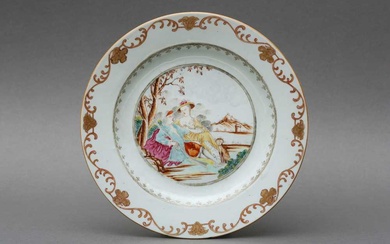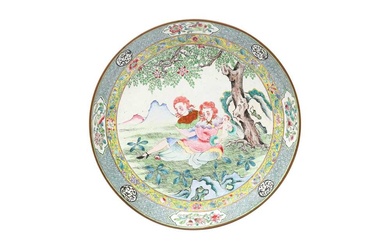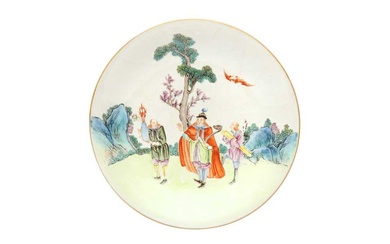A CHINESE 'EUROPEAN SUBJECT' DISH,...
A CHINESE 'EUROPEAN SUBJECT' DISH, c.1750, painted en grisaille with gilt enclosing a classical depiction after Claude Duflos, and contained within an elaborate border with peacock, recumbent dog and classical trophies, 23cm diameter
Chinese Export Ware Porcelain
The story of this long-lasting and highly productive cross-pollination of culture begins with the remote industrial community of inland China, Chingtechen. Porcelain had been produced here on a continual basis for around 2,000 years. From these factories, the unique development of export wares, directly resulting from the trade between East and West, were established. They were designed to meet the particular demands of the Western market, or for specific private commissions by European aristocracy.
Canton, also played an important role in this trading process. It was in this bustling port, that the porcelains were often finished and painted with decorations that would be most appealing to European and later American audiences. There is something particularly intriguing about having a visual manifestation of the vast and at times fractious commercial relationship between Asia and the West. These surviving porcelains, such as the wonderful collection in this sale, capture the interaction of cultures and ideas, particularly the growing fascination on the part of European societies with the fashions and customs of China and Japan.
This fascination was fully exploited by the Chinese porcelain makers who saw a unique opportunity to expand their market beyond Asia. The quality of the export ware varied, a large amount of its production was in blue and white household pieces, which were shipped on mass to Europe. Most porcelain in the China Trade was made for use at the table and they were often moulded in shapes, which reflected European taste and dining customs.
However, finer wares do exist, particularly dating from the period of 1715 - 1740. At this time there was considerable experimentation amongst the porcelain makers, working out what would satisfy the western palette. As such Chinese elements still abound in these examples, such as lot (138), which depicts in exquisite detail the famous Chinese dramatic work Romance of the Western Chamber by playwright Wang Shifu.
In later years the development of specific patterns, which became increasingly popular with western audiences, such as lot (145) which depicts 'The Cherry Pickers', a scene originally derived from a French print,'La Cueillette des Cerises' engraved by Nicolas Ponce (1746 - 1831).It was highly sought after in the Dutch market and wasproduced until the early 19th Century. And lot (144), the 'Valentine' pattern tankard, which is based on a design for a dinner service made in Canton for Commodore George Anson (1697-1762). The original design was a combination of the pastoral and the exotic with details such as the coconut palm and breadfruit tree. It is understood that the design for the service was the work of the First Lieutenant Piercy Brett (1709-1781), Anson's official artist during his 1740-1744 circumnavigation. The decoration was later altered and simplified by Chinese painters when producing it in larger quantities for the export market.
There are numerous examples of en grisaille export porcelain in this collection. A French term used in relation to Chinese ceramics to describe porcelains decorated with black or dark brown over-glaze enamel. All of these examples, depict European subject matter, whether it is man serenading his beloved (lot 142) or borrowing from classical mythology, in the hunting bowl (lot 137) with an interior reserve portrait of Diana the Huntress. They reflect an increasing tendency towards westernized designs. Pictorial decoration was directly copied from prints or drawings or they even sent European porcelain to China to act as models. The technique of en grisaille used by Chinese porcelain painters may reflect the influence of working from black and white engravings. The monochrome palette allowed for a rendering of fine, linear detail.
Niamh Corcoran, October 2019
View it on
Estimate
Time, Location
Auction House
A CHINESE 'EUROPEAN SUBJECT' DISH, c.1750, painted en grisaille with gilt enclosing a classical depiction after Claude Duflos, and contained within an elaborate border with peacock, recumbent dog and classical trophies, 23cm diameter
Chinese Export Ware Porcelain
The story of this long-lasting and highly productive cross-pollination of culture begins with the remote industrial community of inland China, Chingtechen. Porcelain had been produced here on a continual basis for around 2,000 years. From these factories, the unique development of export wares, directly resulting from the trade between East and West, were established. They were designed to meet the particular demands of the Western market, or for specific private commissions by European aristocracy.
Canton, also played an important role in this trading process. It was in this bustling port, that the porcelains were often finished and painted with decorations that would be most appealing to European and later American audiences. There is something particularly intriguing about having a visual manifestation of the vast and at times fractious commercial relationship between Asia and the West. These surviving porcelains, such as the wonderful collection in this sale, capture the interaction of cultures and ideas, particularly the growing fascination on the part of European societies with the fashions and customs of China and Japan.
This fascination was fully exploited by the Chinese porcelain makers who saw a unique opportunity to expand their market beyond Asia. The quality of the export ware varied, a large amount of its production was in blue and white household pieces, which were shipped on mass to Europe. Most porcelain in the China Trade was made for use at the table and they were often moulded in shapes, which reflected European taste and dining customs.
However, finer wares do exist, particularly dating from the period of 1715 - 1740. At this time there was considerable experimentation amongst the porcelain makers, working out what would satisfy the western palette. As such Chinese elements still abound in these examples, such as lot (138), which depicts in exquisite detail the famous Chinese dramatic work Romance of the Western Chamber by playwright Wang Shifu.
In later years the development of specific patterns, which became increasingly popular with western audiences, such as lot (145) which depicts 'The Cherry Pickers', a scene originally derived from a French print,'La Cueillette des Cerises' engraved by Nicolas Ponce (1746 - 1831).It was highly sought after in the Dutch market and wasproduced until the early 19th Century. And lot (144), the 'Valentine' pattern tankard, which is based on a design for a dinner service made in Canton for Commodore George Anson (1697-1762). The original design was a combination of the pastoral and the exotic with details such as the coconut palm and breadfruit tree. It is understood that the design for the service was the work of the First Lieutenant Piercy Brett (1709-1781), Anson's official artist during his 1740-1744 circumnavigation. The decoration was later altered and simplified by Chinese painters when producing it in larger quantities for the export market.
There are numerous examples of en grisaille export porcelain in this collection. A French term used in relation to Chinese ceramics to describe porcelains decorated with black or dark brown over-glaze enamel. All of these examples, depict European subject matter, whether it is man serenading his beloved (lot 142) or borrowing from classical mythology, in the hunting bowl (lot 137) with an interior reserve portrait of Diana the Huntress. They reflect an increasing tendency towards westernized designs. Pictorial decoration was directly copied from prints or drawings or they even sent European porcelain to China to act as models. The technique of en grisaille used by Chinese porcelain painters may reflect the influence of working from black and white engravings. The monochrome palette allowed for a rendering of fine, linear detail.
Niamh Corcoran, October 2019






